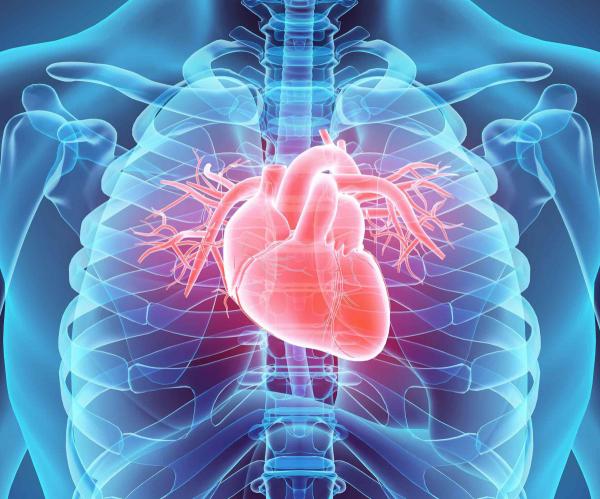Modified Hormone Protects Damaged Hearts
Alteration Helps Prospective Drug Persist Longer in Rodents’ Bodies

Modifying an experimental drug for patients with heart failure helps it remain in the body longer and boosts its therapeutic effects, according to new IRP research.
Even the best construction crew cannot repair a building if it is called away from the site before it can begin its work. Similarly, while the body’s ability to cleanse itself of chemicals can prevent the buildup of toxins, it can also stymie the therapeutic effects of medications. IRP researchers recently found that modifying a prospective treatment for heart failure to help it persist longer in the body boosted its beneficial effects in mice.1
An American has a heart attack roughly every 40 seconds. Even when patients survive these incidents, their hearts may be permanently damaged because the muscle cells that allow the heart to pump blood cannot regrow. The heart cells that remain become larger to compensate for their reduced numbers, a process called cardiac hypertrophy. In addition, specialized cells replace the dead cells with much stiffer material via a process called fibrosis.
“This cardiac repair process can be a double-edged sword,” says IRP senior investigator Elizabeth Murphy, Ph.D. “Initially, these changes allow the heart to pump better, but hypertrophy is also the biggest predictor of heart failure, and the new, stiffer tissue produced by fibrosis doesn’t beat in the way that normal heart tissue does. Eventually, the heart just doesn’t pump well enough to keep you alive.”
Heart failure affects 26 million people worldwide and is often treated with drugs called angiotensin-converting enzyme (ACE) inhibitors that relax and widen blood vessels to reduce the heart’s workload. Unfortunately, some patients don’t get much benefit from these drugs. In an effort to improve treatment for heart failure, scientists at the pharmaceutical company AstraZeneca created a synthetic version of a hormone naturally produced by the body called relaxin. Relaxin is known to reduce fibrosis, cell death, and inflammation, but while the drug showed promise in clinical trials, it was removed from the body so quickly that it failed to provide lasting benefits to patients.
In their new study, Dr. Murphy and her colleagues tested a relaxin molecule that AstraZeneca scientists had modified to slow its removal from the body. While the half-life of the relaxin hormone — the amount of time for its concentration in the blood to be reduced by half — is only a couple minutes in rodents, the half-life of this new compound, named RELAX10, was between three and seven days, depending on the dose and administration method.
Next, Dr. Murphy’s team tested RELAX10 in mice whose hearts had been damaged by two weeks of exposure to a chemical called isoproterenol. Isoproterenol produced significant cardiac hypertrophy and fibrosis and reduced cardiac function in untreated mice, but these effects were lessened in mice that were also given a two-week course of RELAX10, relaxin, or an ACE inhibitor called enalapril while they received isoproterenol. What’s more, when RELAX10 was given after exposure to isoproterenol rather than at the same time, it largely reversed the cardiac hypertrophy and fibrosis caused by the isoproterenol.
“People who have had a heart attack are at risk for developing cardiac hypertrophy and possibly going into heart failure, so this is a drug that could be given to someone who has had a heart attack to help prevent that,” Dr. Murphy explains. “I think it could both be preventative and also be used as a treatment for someone who already has mild hypertrophy.”
Additional experiments examined RELAX10’s effect on the eNOS signaling pathway, which is thought to play a critical role in relaxin’s beneficial effects on the cardiovascular system.2 Isoproterenol and RELAX10 individually increased activation of the eNOS pathway, and giving both compounds to the mice increased eNOS signaling more than either did by itself. Intriguingly, giving mice both isoproterenol and the ACE inhibitor enalapril did not activate the eNOS pathway any more than isoproterenol alone, suggesting that RELAX10 may provide therapeutic effects by interacting with different bodily processes than ACE inhibitors do.
If future studies confirm that RELAX10 and ACE inhibitors affect different bodily processes, combining a relaxin-based drug with an ACE inhibitor could lead to synergistic effects that help patients’ hearts more than either treatment would by itself. Dr. Murphy is interested in examining that hypothesis in future studies, as well as the effects of RELAX10 in animal models with more severely damaged hearts than the mice in the recent study. Meanwhile, Dr. Murphy’s collaborators at AstraZeneca will move the new treatment closer to the clinic by testing relaxin-based therapy in clinical trials with human patients.
“When you do a study, you never know what will happen, so it’s always very satisfying when it looks like your therapy could be beneficial for treating a disease,” Dr. Murphy says. “It doesn’t always happen, but when it does it makes your day.”
Subscribe to our weekly newsletter to stay up-to-date on the latest breakthroughs in the NIH Intramural Research Program.
References:
[1] Human Relaxin-2 Fusion Protein Treatment Prevents and Reverses Isoproterenol-Induced Hypertrophy and Fibrosis in Mouse Heart. Sun J, Hao W, Fillmore N, Ma H, Springer D, Yu ZX, Sadowska A, Garcia A, Chen R, Muniz-Medina V, Rosenthal K, Lin J, Kuruvilla D, Osbourn J, Karathanasis SK, Walker J, Murphy E. J Am Heart Assoc. 2019 Dec 17;8(24):e013465. doi: 10.1161/JAHA.119.013465.
[2] Relaxin counteracts myocardial damage induced by ischemia-reperfusion in isolated guinea pig hearts: evidence for an involvement of nitric oxide. Masini E, Bani D, Bello MG, Bigazzi M, Mannaioni PF, Sacchi TB. Endocrinology. 1997;138:4713–4720.
Related Blog Posts
This page was last updated on Tuesday, May 23, 2023
